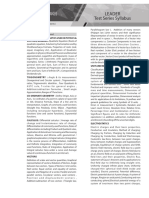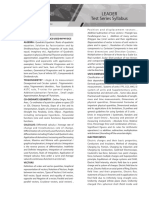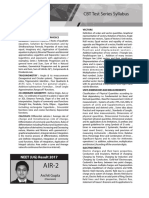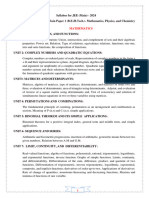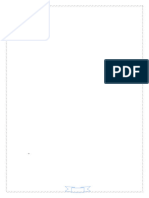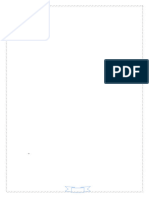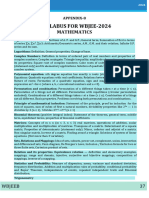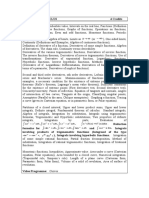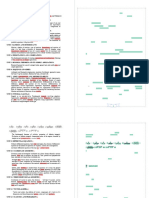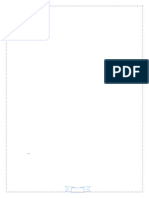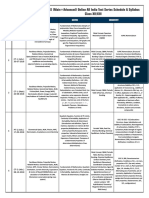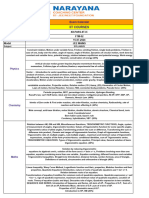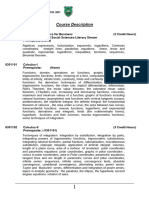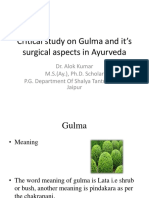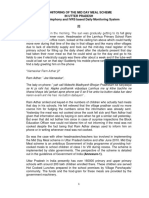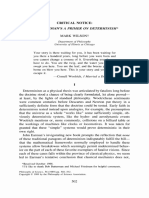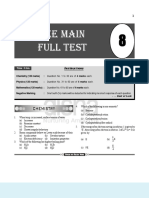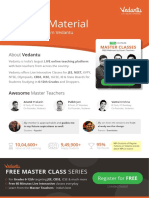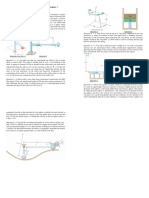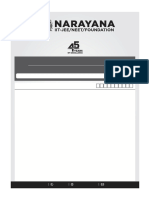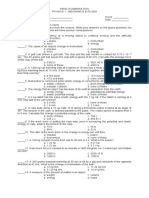Pre Medical Nurture Syllabus
Pre Medical Nurture Syllabus
Uploaded by
PREM277272Copyright:
Available Formats
Pre Medical Nurture Syllabus
Pre Medical Nurture Syllabus
Uploaded by
PREM277272Original Description:
Copyright
Available Formats
Share this document
Did you find this document useful?
Is this content inappropriate?
Copyright:
Available Formats
Pre Medical Nurture Syllabus
Pre Medical Nurture Syllabus
Uploaded by
PREM277272Copyright:
Available Formats
Pre-Medical (NEET (UG), AIIMS) NURTURE
Test Series Syllabus
[For both English/Hindi Medium Students]
PHYSICS is the reverse process of differentiation, Indefinite
and Definite Integration, Integration of commonly
Test No. Topic Covered used functions, Rules of Integration, Application of
01 BASIC MATHEMATICS USED IN PHYSICS Integral calculus: Area under a curve and Average
value of a continuous function in an interval ) ,
ALGEBRA : Quadratic Equation ( Roots of quadratic
equation, Solution by Factorization and by VECTORS : Definition of scalar and vector quantities,
Shridharacharya Formula, Properties of roots (real, Graphical representation of vectors, Notation of
equal, imaginary etc), Application of Quadratic Vectors, Angle between two vectors , Types of Vectors
equation in physics), Binomial Theorem and binomial ( Unit vector, Null vector, Equal vectors and equality of
approximation, Logarithm and Exponents ( Laws of vectors, opposite and Negative of a vector, Parallel
logarithms and exponents with applications / and anti-parallel vectors, Co-planar vectors, axial
examples), Series ( Arithmetic Progression and its vectors) , Position and displacement vectors ,
general term and Sum, Sum of first n Natural Addition/subtraction of two vectors ( Triangle law,
numbers, Geometrical Progression and its general Parallelogram law ), Addition of many vectors
term and Sum, Sum of infinite GP ), Componendo & (Polygon law ),Unit vectors and their significance
Dividendo rule. (Representation of vector in terms of unit vector in
plane and in space ) , Resolution of a Vector into
TRIGONOME TRY : Angle & its measurement
components i.e. Cartesian Components in two and
(Sexagesimal and Circular system) , Trigonometric-
t h re e d i m e n s i o n s a n d D i re c t i o n Co s i n e s ,
ratios, Trigonometric identities , Four Quadrants &
Multiplication or Division of a Vector by a Scalar (i.e.
ASTC rule, T-ratios for general angles , Addition/
Real number) ,Scalar (Dot) product of two Vectors and
subtraction Formulae , Small angle Approximation,
component of a vector in the direction of another
Ranges of T-functions.
vector , Vector (Cross) product of two Vectors with its
CO-ORDINATE GEOMETRY : Define Origin, Axis or geometrical interpretation and Right hand rule for
Axes, Co-ordinates of a point in a plane or space (2D direction.
or 3D), Distance Formula, Slope of a line and its
interpretation, Graphs of commonly used functions UNIT, DIMENSIONS AND MEASUREMENTS
(Straight line, Parabola, Circle, Ellipse , Hyperbola I Classification of Physical Quantities according to their
ncluding rectangular hyperbola , Sinusoidal dependency i.e. Fundamental (or Base) and Derived
functions (sine and cosine functions), Exponential quantities , Need for measurement ( Units of
functions. measurement ) , Systems of units ( FPS, CGS, MKS, SI
CALCULUS: Differential calculus ( Average rate of system of units and Supplementar y units,
change and I nstantaneous rate of change, fundamental and derived units , Some idea about
Differentiation of commonly used functions, Rules of Practical and Improper units) , Standards of Length,
differentiation including Product and Quotient rules, mass and time measurements, Dimensions of
Application of derivatives: Increasing and Decreasing physical quantities, Dimensional Formulae of
nature, Maxima and Minima with geometrical / important physical quantities, Dimensional analysis
graphical explanation ), Integral calculus ( Integration and its applications & its limitations, SI prefixes and
general guidelines for using Symbols of SI units ,
Errors in measurement ( Systematic, Random and
NEET (UG) Result 2017 Least count Errors) , Accuracy and precision of
measuring instruments ; Absolute Error, Relative
AIR-2 Error, Percentage Error and Combination of Errors ,
Significant figures and its rules for Arithmetic
operations ( i.e. addition, subtraction, multiplication
and division) ,Rounding off the uncertain digits.
Archit Gupta
02 KINEMATICS
(Classroom)
(Motion along a straight line and Motion in a Plane)
Pre-Medical (NEET (UG), AIIMS) NURTURE
Test Series Syllabus
[For both English/Hindi Medium Students]
Motion and Rest with introduction of frame of under the curve) , Kinetic energy , Work-energy
reference , Variables of Translatory Motion ( Position/ theorem for a Constant and a Variable force , Concept
Displacement / Path length(Distance) , Velocity/ of potential energy, conservative forces and non-
Speed / Average Velocity / Average Speed , conservative forces. Gravitational Potential Energy ,
Acceleration / Average Acceleration ) , Relation Potential energy versus position graph and stable,
among various variables of motion and their unstable & neutral equilibrium , Spring force and
applications to variable acceleration , Equations of Elastic Potential energy of a spring , Conservation of
Motion with constant acceleration (scalar and vector mechanical energy (kinetic and potential energies) ,
forms), Motion along a straight line, velocity-time and Power ( Instantaneous and Average power).
position-time graphs for uniformly accelerated
CIRCULAR MOTION
motion (graphical treatment) , Motion under gravity,
Free -fall , Motion in a plane with constant Kinematics of circular motion (Variables of motion
acceleration , Projectile Motion – Ground to Ground (Angular Displacement, Angular Velocity, Angular
projection, Projection from a height (Horizontal acceleration), Relations among Angular Variables for
projection) , Relative Motion in one-dimensions , constant angular acceleration , General relation
Relative Velocity in two dimensions ( Rain-Man among angular variables ) , Dynamics of uniform
problem, River-Boat Problem & wind based circular motion. Centripetal force, examples of
questions) circular motion (vehicle on level circular road, vehicle
on banked road) , Dynamics of non-uniform circular
03 LAWS OF MOTION AND FRICTION motion( Motion in a vertical circle)
Intuitive concept of force , Basic or Fundamental
06 COLLISIONS AND CENTRE OF MASS
forces in nature , The law of Inertia, Newton's first law
of motion ,Momentum and Newton's second law of Impulse of a force and Impulse-Momentum theorem,
motion; impulse , Newton's third law of motion , Idea about Impulsive forces,
Common forces in mechanics-Weight, Normal Law of conservation of linear momentum and its
reaction, Friction, Contact force, Tension in string , applications, Elastic and inelastic collisions in one and
Free Body diagram, Equilibrium of concurrent forces- two dimensions (Head-on and Oblique collisions),
Lami's theorem, Motion of bodies in contact or Coefficient of restitution and line of impact,
connected by strings, Pulley systems , Frame of Expression of loss in Kinetic energy in inelastic
Reference-Inertial and Non Inertial Frames. Pseudo collision,
Force and its applications , Cause of Friction, Static Centre of mass of discrete system: two-particle
and Kinetic friction , Laws of friction, Limiting Static system and n-particle system, Centre of mass of
and Kinetic friction coefficients, Angle of Friction, continuous system: General formula, Centre of mass
Angle of Repose , Rolling friction, Lubrication. of symmetrical rigid bodies; centre of mass of uniform
04 Syllabus of Test 1, 2 & 3 rod , Centre of mass of composite and truncated
bodies , Motion of centre of mass: Velocity,
05 WORK, ENERGY, POWER
Acceleration and linear momentum vector of centre
Work done by a constant force (use of dot product) of mass of the system , Momentum conservation and
and variable force(use of definite integration i.e. area centre of mass motion.
07 Syllabus of Test # 1, 2, 3, 5 & 6
NEET (UG) Result 2017
08 ROTATIONAL MOTION
AIR-3 Kinematics of Rotational Motion about a fixed axis:
Comparison of linear and rotational motions,
Moment of inertia, radius of gyration and its
significance. Values of M.I. for simple geometrical
Manish Mulchandani objects (Ring, Rod and Disc with derivation and
(Classroom) others with no derivation).Statement of parallel and
Pre-Medical (NEET (UG), AIIMS) NURTURE
Test Series Syllabus
[For both English/Hindi Medium Students]
perpendicular axes theorems and their applications, First law of thermodynamics. Cyclic, Isochoric,
Moment of a force-torque, Equilibrium of rigid Isobaric, Isothermal and Adiabatic processes, Second
bodies, Angular momentum, Relation between law of the thermodynamics: Reversible and
torque and Angular momentum, Conservation of irreversible processes. Heat engines and
angular momentum with some examples , Pure refrigerators.
Rolling or rolling motion on a smooth/rough
Kinetic theory of gases : Gas Laws, Equation of state of
horizontal surface. Expression for Rotational Kinetic
a perfect gas, Brief idea of van der Waals' equation
Energy, Rolling motion on an inclined plane,
and Critical temperature, Assumptions, Concept of
Expression for acceleration and minimum friction
pressure. Different types of speeds of gas molecules,
coefficient.
Maxwell's velocity distribution curve, Kinetic energy
09 THERMAL PHYSICS and temperature; Degrees of freedom, Law of
(Thermal Expansion, Calorimetry, Heat Transfer, KTG equipartition of energy (statement only) and
& Thermodynamics) application to specific heat capacities of gases;
Concept of mean free path.
Temperature and Thermal Expansion: (Temperature,
Temperature scales, Brief idea about thermometers, 10 PROPERTIES OF MATTER AND FLUID
Thermal expansion; thermal expansion of solids, MECHANICS
liquids, and gases. Anomalous expansion) Elastic behavior, Stress-strain relationship, Hooke's
Calorimetry :(Heat, Heat capacity, Specific heat law, Young's modulus, bulk modulus, shear modulus
capacity, Molar heat capacity, Water Equivalent, Heat of rigidity, Poisson's ratio; elastic energy. Pressure,
of transformation – latent heat, Principle of Pascal's law, Archimedes' Principle and Buoyancy.
Calorimetry, Heating curve, Phase diagram) Floatation and Translatory equilibrium, Variation of
Pressure with Depth, Atmospheric pressure and
Heat transfer
Gauge Pressure, Hydraulic Machines, Streamline and
Conduction: (Process, Steady State, Law of turbulent flow, Critical velocity and Reynolds's
Conduction, Thermal conductivity, Thermal number, Principle of Continuity, Bernoulli's theorem
resistance, Series and Parallel combinations of rods, and its applications. Speed of Efflux: Torricelli's law,
Growth of ice on ponds) , Convection: Process, Idea Venturi-meter, Dynamic lift, Viscosity, Newton's law of
about Natural and Forced Convection, Radiation: viscous force, Stokes' law, terminal velocity,Surface
Qualitative ideas of Black Body Radiation, Ideal Black energy and surface tension, angle of contact, excess
Body, Absorptive Power, Emissive Power, Spectral of pressure, application of surface tension ideas to
Emissive Power, Kirchhoff's Law and its applications, drops, bubbles and capillary rise. Detergent and
Stefan's Law, Newton's law of cooling, Wien's surface tension
displacement law and Green House effect, Solar
11 Syllabus of Test # 8, 9 & 10
constant.
12 GRAVITATION
Thermodynamics :Thermal equilibrium and
definition of temperature (Zeroth law of The universal law of gravitation(Newton's law of
Thermodynamics). Heat, work and internal energy. Gravitation), Gravitational Field and its Intensity, Brief
idea about Iner tial and Gravitational mass,
Acceleration due to gravity and its variation with
NEET (UG) Result 2017 altitude and depth. Idea about variation in g due to
Shape and Rotation of earth, Gravitational potential
AIR-5 energy and gravitational potential, Kepler's laws of
planetary motion (The law of orbits, Areas and
Periods), Motion of Planets and Satellites in Circular
orbits ,Orbital velocity of a satellite, Total Energy and
Abhishek Dogra Binding Energy of a satellite, Escape velocity and
(Classroom) escape energy, Geostationary satellites, Idea about of
polar satellites, Weightlessness.
Pre-Medical (NEET (UG), AIIMS) NURTURE
Test Series Syllabus
[For both English/Hindi Medium Students]
OSCILLATIONS CHEMISTRY
(SHM, damped and forced oscillations& Resonance) Test No. Topic Covered
Periodic (harmonic) motion and Oscillatory motion, 01 SOME BASIC CONCEPTS OF CHEMISTRY : General
Periodic motion-period, frequency, displacement as a Introduction: Importance and scope of chemistry.
function of time, Periodic functions, Simple harmonic Laws of chemical combination, Dalton’s atomic
motion (SHM) and its equation; Velocity, Acceleration theory: concept of elements, atoms and molecules.
and Phase, Oscillations of a spring-restoring force and Atomic and molecular masses. Mole concept and
force constant. Equivalent spring constant of Series molar mass; percentage composition and empirical
and parallel combinations, Energy in SHM –Kinetic and molecular formula; chemical reactions,
and Potential energies, Simple pendulum-derivation stoichiometry and calculations based on
stoichiometry.
of expression for its time period, Superposition of two
SHMs of Same Frequency in the same direction, Free, 02 STRUCTURE OF ATOM : Subatomic particles,
forced and damped oscillations (qualitative ideas Atomic models. Atomic number, isotopes and
only), resonance. isobars. Concept of shells and subshells, dual nature
of matter and light, de Broglie’s relationship,
13 WAVE MOTION AND DOPPLER'S EFFECT Heisenberg uncertainty principle, Bohr's Model
Wave motion, Mechanical Waves, Longitudinal and concept of orbital, quantum numbers, shapes of s,p
transverse waves, Equation of Plane Progressive and d orbitals, rules for filling electrons in orbitals-
Aufbau principle, Pauli's exclusion principles and
waves, Velocity of Transverse mechanical waves,
Hund’s rule, electronic configuration of atoms,
Intensity of waves , Sound waves: Audible, Infrasonic
stability of half filled and completely filled orbitals.
and Ultrasonic waves , Speed of sound waves:
Newton's formula and Laplace correction, Effect of 03 C L A S S I F I C AT I O N O F E L E M E N T S A N D
PERIODICITY IN PROPERTIES : Why do we need to
temperature, Pressure and Humidity on speed of
classify elements, Genesis of periodic classification.
Sound waves , Some idea about description of sound
Modern periodic law and long form of periodic table,
waves as Displacement and Pressure waves, Nomenclature of elements with atomic number >
Characteristics of sound waves: Pitch, Loudness and 100, Electronic configuration of elements and types
Quality, Reflection and transmission of waves & Echo , of elements. periodic trends in properties of
Principle of superposition of waves, Interference and elements- atomic radii, ionic radii, ionization
Beats, Stationary waves, Standing waves in strings enthalpy, electron gain enthalpy, electronegativity,
and organ pipes, fundamental mode and harmonics. valency.
Resonance tube , Doppler Effect in Sound waves and 04 Syllabus of Test # 1, 2 & 3
Light Waves.
05 CHEMICAL BONDING AND MOLECULAR
14 Syllabus of Test # 8, 9 10, 12 & 13 STRUCTURE : Kossel Lewis Approach to Chemical
15 FULL Syllabus Bonding, Valence electrons, ionic bond, covalent
bond, bond parameters, Lewis structure, polar
16 FULL Syllabus character of covalent bond, valence bond theory,
resonance, geometry of molecules, VSEPR theory,
concept of hybridization involving s, p and d orbitals
and shapes of some simple molecules, molecular
orbital theory of homonuclear diatomic molecules
NEET (UG) Result 2017 (qualitative idea only). Hydrogen bond, Dipole
Moment.
AIR-7 STATES OF MATTER : Gases and Liquids : Three
states of matter, intermolecular interactions, types of
bonding, melting and boiling points, role of gas laws
of elucidating the concept of the molecule, Boyle’s
Kanishh Tayal law, Charle’s law, Gay Lussac’s law, Avogadro’s law,
(Classroom ) ideal behaviour of gases, empirical derivation of gas
equation. Avogadro number, ideal gas equation.
Pre-Medical (NEET (UG), AIIMS) NURTURE
Test Series Syllabus
[For both English/Hindi Medium Students]
Kinetic energy and molecular speeds (elementary hydrides ionic, covalent and interstitial; physical and
idea), deviation from ideal behaviour, liquefaction of chemical properties of water, heavy water; hydrogen
gases, critical temperature. peroxide-preparation, reactions, uses and structure,
LIQUID STATE : Vapour pressure, viscosity and surface Dihydrogen as a fuel.
tension (qualitative idea only, no mathematical ORGANIC CHEMISTRY SOME BASIC PRINCIPLES
derivations). A N D T E C H N I Q U E S : General introduc tion,
06 THERMODYNAMICS : First law of thermodynamics- Tetravalence of Carbon : Shapes of organic
internal energy and enthalpy, heat capacity and compounds, structural representation of organic
specific heat, measurement of rU and rH, Hess’s compounds, methods of purification, qualitative and
law of constant heat summation, enthalpy of : bond quantitative analysis, classification and IUPAC
dissociation, combustion, formation, atomization, nomenclature of organic compounds. Electronic
sublimation, phase transition, ionization, solution displacements in a covalent bond: inductive effect,
and dilution. Introduction of entropy as state electromeric effect, resonance and hyper conjugation.
function, Second law of thermodynamics, Gibbs Homolytic and heterolytic fission of a covalent bond:
e n e rg y c h a n g e fo r s p o nt a n e o u s a n d n o n - free radials, carbocations, carbanions; electrophiles
spontaneous process, criteria for equilibrium and and nucleophiles, types of organic reactions.
spontaneity. Third law of thermodynamics- Brief 10 s–BLOCK ELEMENTS (Alkali and Alkaline Earth
introduction. Metals) : Group I and group II elements:
07 Syllabus of Test # 1, 2, 3, 5 & 6 General introduction, electronic configuration,
08 EQUILIBRIUM : Equilibrium in physical and chemical occurrence, anomalous properties of the first
processes and applications, dynamic nature of element of each group, diagonal relationship, trends
equilibrium, law of chemical equilibrium, equilibrium in the variation of properties (such as ionization
constant, factors affecting equilibrium-Le Chatelier’s enthalpy, atomic and ionic radii), trends in chemical
principle. Relationship between equilibrium reactivity with oxygen, water, hydrogen and
constant K and reaction Quotient Q. halogens; uses. Preparation and Properties of some
important Compounds: Sodium carbonate, sodium
Ionic equilibrium - ionization of acids and bases, chloride, sodium hydroxide and sodium
strong and weak electrolytes, degree of ionization, hydrogencarbonate, biological importance of
ionization of polybasic acids, acid strength, concept sodium and potassium. Anomalous behaviour of Be.
of pH., Hydrolysis of salts (elementary idea)., buffer
solutions, Henderson equation, solubility product, Industrial use of lime and limestone, biological
common ion effect (with illustrative examples). impor tance of Mg and Ca. Some Impor tant
Compound of Calcium.
09 REDOX REACTIONS : Concept of oxidation and
reduction, redox reactions, oxidation number, 11 Syllabus of Test # 8, 9 & 10
balancing redox reactions in terms of loss and gain of 12 SOME p–BLOCK ELEMENTS : General Introduction
electron and change in oxidation numbers, of p-Block Elements.
application of oxidation number, equivalent concept
Group 13 Elements : General introduction,
of oxidising and reducing.
electronic configuration, occurrence, variation of
HYDROGEN : Position of Hydrogen in Periodic Table, properties, oxidation states, trends in chemical
Dihydrogen (H2), Hydrides, Occurrence, isotopes, reactivity, anomalous properties of first element of
preparation, properties and uses of hydrogen; the group, Boron, some important compounds:
borax, boric acids, boron hydrides. Aluminium: uses,
NEET (UG) Result 2017 reactions with acids and alkalies.
Group 14 Elements : General introduction,
AIR-9 electronic configuration, occurrence, variation of
properties, oxidation states, trends in chemical
reactivity, anomalous behaviour of first element.
Carbon, allotropic forms, physical and chemical
Aryan Raj Singh properties: uses of some important compounds :
(Distance) (Carbon and Silicon) oxides, Important compounds
of silicon and a few uses: silicon tetrachloride,
Pre-Medical (NEET (UG), AIIMS) NURTURE
Test Series Syllabus
[For both English/Hindi Medium Students]
silicones, silicates and zeolites & their uses. BIOLOGY
13 HYDROCARBONS : Alkanes- Nomenclature, Test No. Topic Covered
isomerism, conformations (ethane only), physical
01 DIVERSITY IN LIVING WORLD : What is living? ;
properties, chemical reactions including free radical
Biodiversity; Need for classification; Three domains of
mechanism of halogenation, combustion and life; Taxonomy & Systematics; Concept of species and
pyrolysis. taxonomical hierarchy; Binomial nomenclature; Tools
Alkenes - Nomenclature, structure of double bond for study of Taxonomy – Museums, Zoos, Herbaria,
(ethene), geometrical isomerism, physical properties, Botanical gardens.
methods of preparation, chemical reactions: addition Five kingdom classification; salient features and
of hydrogen, halogen, water, hydrogen halides classification of Monera; Protista and Fungi into major
(Markovnikov’s addition and peroxide effect), groups; Lichens; Viruses and Viroids. Prokaryotic Cell
ozonolysis, oxidation, mechanism of electrophilic (Bacteria). Salient features and classification of plants
addition. into major groups-Algae, Bryophytes, Pteridophytes,
Gymnosperms and Angiosperms (three to five salient
Alkynes - Nomenclature, structure of triple bond and distinguishing features and at least two
( e t hy n e ) , p hys i c a l p ro p e r t i e s, m e t h o d s o f examples of each categor y); Angiosperms-
preparation, chemical reactions: acidic character of classification up to class, characteristic features and
alkynes, addition reaction of hydrogen, halogens, examples).
hydrogen halides and water. 02 A N I M A L K I N G D O M : S alient features and
Aromatic Hydrocarbons - Introduction, IUPAC classification of animals-nonchordate up to phyla
level and chordate up to classes level (three to five
nomenclature; Benzene; resonance, aromaticity;
salient features and at least two examples).
chemical properties: mechanism of electrophilic
substitution- Nitration sulphonation, halogenation, 03 STRUCTURAL ORGANISATION IN ANIMALS:
Friedel Craft’s alkylation and acylation; directive Animal tissues- Epithelial tissues, connective tissues,
influence of functional group in mono-substituted muscle tissue, neural tissue, organs and organ
system, respiratory, nervous and reproductive) of an
benzene; carcinogenicity and toxicity.
insect Earthworm cockroach. (Brief account only)
ENVIRONMENTAL CHEMISTRY : Environmental
04 Syllabus of Test 1, 2 & 3
pollution: Air, water and soil pollution, chemical
reactions in atmosphere, smogs, major atmospheric 05 STRUCTURAL ORGANISATION IN PLANTS :
pollutants, acid rain, ozone and its reactions, effects Morphology and modifications, functions of different
par ts of flowering plants: Root, Stem, Leaf,
of depletion of ozone layer, greenhouse effect and
Inflorescence, flower, Fruit and Seed & Families
global warming, pollution due to industrial wastes, [ Cruciferae, Fabaceae, solanaceae liliaceae]
green chemistry as an alternative tool for reducing
pollution, strategy for control of environmental Anatomy: Tissues , tissue system, internal structure
pollution. of Root, Stem, Leaf, secondary Growth.
06 CELL STRUCTURE AND FUNCTION : Cell theory
14 Syllabus of Test # 8, 9 10, 12 & 13
and cell as the basic unit of life; Structure of
15 Full Syllabus prokaryotic and eukaryotic cell; Plant cell and animal
cell; Cell envelope, cell membrane, cell wall; Cell
16 Full Syllabus organelles-structure and function; Endomembrane
system-endoplasmic reticulum, Golgi bodies,
lysosomes, vacuoles; mitochondria, ribosomes,
plastids, micro bodies; Cytoskeleton, cilia, flagella,
centrioles (ultra structure and function); Nucleus-
AIIMS Result 2017 nuclear membrane, chromatin, nucleolus.
Biomolecules-structure and function of proteins,
AIR-1 carbohydrates, lipids, nucleic acids
Cell division: Cell cycle, mitosis, meiosis and their
significance.
NISHITA PUROHIT 07 Syllabus of Test # 1, 2, 3, 5 & 6
(Classroom ) 08 PLANT PHYSIOLOGY - I : Transport in plants:
Movement of water, gases and nutrients; Cell to cell
transport-Diffusion, facilitated diffusion, active
Pre-Medical (NEET (UG), AIIMS) NURTURE
Test Series Syllabus
[For both English/Hindi Medium Students]
transport; Plant – water relations – Imbibition, water indigestion, constipation, vomiting, jaundice,
potential, osmosis, plasmolysis; Long distance diarrhea, Vitamins.
transport of water – Absorption, apoplast, symplast, Locomotion and Movement: Types of movement-
transpiration pull, root pressure and guttation; ciliar y, flagellar, muscular; Skeletal muscle -
Transpiration-Opening and closing of stomata; contractile proteins and muscle contraction; Skeletal
Uptake and translocation of mineral nutrients- system and its functions (To be dealt with the relevant
Transport of food, phloem transport, Mass flow practical of Practical syllabus); Joints; Disorders of
hypothesis; Diffusion of gases (brief mention). muscular and skeletal system-Myasthenia gravis,
Mineral nutrition: Essential minerals, macro and Tetany, Muscular dystrophy, Arthritis, Osteoporosis,
micronutrients and their role; Deficiency symptoms; Gout.
Mineral toxicity; Elementary idea of Hydroponics as a 11 Syllabus of Test # 8, 9 & 10
method to study mineral nutrition; Nitrogen
metabolism-Nitrogen cycle, biological nitrogen 12 H U M A N P HYS I O LO G Y- I I : Breathing And
fixation. Respiration: Respiratory organs in animals (recall
only); Respiratory system in humans; Mechanism of
09 PLANT PHYSIOLOGY - II : Photosynthesis as a
breathing and its regulation in humans-Exchange of
means of Autotrophic nutrition; Site of
gases, transport of gases and regulation of
photosynthesis take place; pigments involved in
respiration; Respiratory volumes; Disorders related to
Photosynthesis (Elementary idea); Photochemical
respiration-Asthma, Emphysema, Occupational
and biosynthetic phases of photosynthesis; Cyclic
respiratory disorders.
and non c yclic and photophosphor ylation;
Chemiosmotic hypothesis; Photorespiration C3 and C4 Body fluids and circulation- Blood, Blood Corpuscles,
pathways; Factors affecting photosynthesis. Blood Groups, Blood clotting, RH factor.
Respiration: Exchange gases; Cellular respiration- Human circulatory system- Structure of human
glycolysis, fermentation (anaerobic), TCA cycle and heart and blood vessels; Cardiac cycle, cardiac
electron transport system (aerobic); The respiratory output, ECG, Double circulation; Regulation of
balance sheet, Amphibolic pathways; Respiratory cardiac activity; Disorders of circulatory system-
quotient. Hypertension, Coronary artery disease, Angina
pectoris, Heart failure.
Plant growth and development: Seed germination;
Phases of Plant growth and plant growth rate; Excretory products and their elimination: Modes
Conditions of growth; Differentiation, of excretion Ammonotelism, ureotelism, uricotelism;
dedifferentiation and redifferentiation; Sequence of Human excretory system structure and fuction;
developmental process in a plant cell; Growth Urine formation, Osmoregulation; Regulation of
regulators-auxin,gibberellin, cytokinin, ethylene, kidney function-Renin-angiotensin, Atrial Natriuretic
ABA; Seed dormancy; Vernalisation; Photoperiodism. Factor, ADH and Diabetes insipidus; Role of other
Enzymes- types, properties, enzyme action, factors organs in excretion; Disorders; Uraemia, Renal failure,
affecting enzyme action. Renal calculi, Nephritis; Dialysis and artificial kidney.
10 H U M A N P HYS I O LO G Y - I : Digestion and 13 HUMAN PHYSIOLOGY - III : Neural Control And
absorption; Alimentary canal and digestive glands; Coordination: Neuron and nerves; Nervous system
Role of digestive enzymes and gastrointestinal in humans- central nervous system, peripheral
hormones; Peristalsis, digestion, absorption and nervous system and visceral nervous system;
assimilation of proteins, carbohydrates and fats; Generation and conduction of nerve impulse; Reflex
Caloric value of proteins, carbohydrates and fats; action; Sense organs; Elementary structure and
Egestion; Nutritional and digestive disorders – PEM, function of eye and ear.
Chemical coordination and regulation: Endocrine
glands and hormones; Human endocrine system-
AIIMS Result 2017 Hypothalamus, Pituitary, Pineal, Thyroid, Parathyroid,
Adrenal, Pancreas, Gonads; Mechanism of hormone
action (Elementary Idea); Role of hormones as
AIR-2 messengers and regulators, Hypo-and hyperactivity
and related disorders (Common disorders e.g.
D w a r f i s m , A c r o m e g a l y, C r e t i n i s m , g o i t e r,
exopthalmic goiter, diabetes, Addison's disease).
ARCHIT GUPTA 14 Syllabus of Test # 8, 9 10, 12 & 13
(Classroom)
15 Full Syllabus
16 Full Syllabus
You might also like
- AP Physics 1 Experimental Design ReviewDocument13 pagesAP Physics 1 Experimental Design ReviewnameNo ratings yet
- 14 Dynamics SolutionDocument12 pages14 Dynamics SolutionAdrian Antonio Torres100% (2)
- Neet Ug Test Series Nurture SyllabusDocument8 pagesNeet Ug Test Series Nurture SyllabusAbdur Rahaman V-2019-01No ratings yet
- Pre Medical Nurture Test Series Detailed SyllabusDocument8 pagesPre Medical Nurture Test Series Detailed SyllabusLishaNo ratings yet
- Neet Ug Test Series Leader SyllabusDocument12 pagesNeet Ug Test Series Leader Syllabusss3227618No ratings yet
- Neet Ug Test Series Leader SyllabusDocument12 pagesNeet Ug Test Series Leader SyllabusRitesh ji RajNo ratings yet
- Neet Ug Test Series Leader SyllabusDocument12 pagesNeet Ug Test Series Leader Syllabusẞ RasesvariNo ratings yet
- Neet Ug Leader Detailed SyllabusDocument12 pagesNeet Ug Leader Detailed SyllabusSaniya KhanNo ratings yet
- Pre Medical AIIMS CBT SyllabusDocument12 pagesPre Medical AIIMS CBT SyllabusShubhra Kanti GopeNo ratings yet
- Medical 2016 17 PDFDocument11 pagesMedical 2016 17 PDFRiteshNo ratings yet
- Neet (Ug) & Aiims Neet (Ug) & Aiims: Syllabus SyllabusDocument11 pagesNeet (Ug) & Aiims Neet (Ug) & Aiims: Syllabus SyllabusFun BoxNo ratings yet
- Pre Medical Class XII SyllabusDocument12 pagesPre Medical Class XII SyllabusDebasis PandaNo ratings yet
- JEE MAIN New Approved SyllabusDocument14 pagesJEE MAIN New Approved SyllabusAyaan FuzailNo ratings yet
- JEE Mains Advanced Latest SyllabusDocument24 pagesJEE Mains Advanced Latest SyllabusViki HNo ratings yet
- #JeesyllabusDocument25 pages#Jeesyllabusshubhtwr2480No ratings yet
- Syllabus for Jee Main 2024 as on 01 November 2023Document21 pagesSyllabus for Jee Main 2024 as on 01 November 2023sachinpandey5639No ratings yet
- JEE Main 2024 SyllabusDocument14 pagesJEE Main 2024 Syllabuskovape7455No ratings yet
- MathematicsDocument23 pagesMathematicsgjxj7zg877No ratings yet
- Syllabus for Jee Main 2024 as on 01 November 2023Document21 pagesSyllabus for Jee Main 2024 as on 01 November 2023elysianananya9911No ratings yet
- JEE MAINS Marked Syllabus 2024Document21 pagesJEE MAINS Marked Syllabus 2024Anant M NNo ratings yet
- Jee Notes Class 12 11Document15 pagesJee Notes Class 12 11tanviiverseNo ratings yet
- Syllabus for Jee Main 2024 as on 01 November 2023 (1)Document21 pagesSyllabus for Jee Main 2024 as on 01 November 2023 (1)vandit442No ratings yet
- Syllabus ComparisonDocument22 pagesSyllabus Comparisonrikofa5678No ratings yet
- Article 29262Document19 pagesArticle 29262sujathabudharapu1983No ratings yet
- Final GCC Syllabus-1Document13 pagesFinal GCC Syllabus-1ebsp7as7No ratings yet
- RPS T.S. XI Class ScheduleDocument3 pagesRPS T.S. XI Class ScheduleMohit YadavNo ratings yet
- JEE Main Syllabus 1234Document9 pagesJEE Main Syllabus 1234Adyasha KhatuaNo ratings yet
- Ojee Btech 2023Document4 pagesOjee Btech 2023Jerry MishraNo ratings yet
- Information Bulletin-WbjeeDocument12 pagesInformation Bulletin-WbjeesunnycheerlaNo ratings yet
- WBJEE 2024 SyllabusDocument10 pagesWBJEE 2024 Syllabussm3935107No ratings yet
- MTE-01 Calculus 4 Credits:, Cos SinDocument14 pagesMTE-01 Calculus 4 Credits:, Cos SinNepsonNo ratings yet
- WBJEE 2018 SyllabusDocument8 pagesWBJEE 2018 SyllabusNishit kumar100% (1)
- Xi Stu Ic&Ir Iit Cta 02Document1 pageXi Stu Ic&Ir Iit Cta 02utkarshvaibhavmail02No ratings yet
- Untitled Rich Text DiffDocument21 pagesUntitled Rich Text Diffkanangupta123No ratings yet
- Syllabus WBJEEM-2015 25092014Document17 pagesSyllabus WBJEEM-2015 25092014Vishwajeet KumarNo ratings yet
- 2025 JM Syllabus B.EDocument3 pages2025 JM Syllabus B.EpppaissceNo ratings yet
- NTA JEE Mains 2025 SyllabusDocument17 pagesNTA JEE Mains 2025 Syllabusberwalyogesh6055No ratings yet
- Syllabus UGDocument30 pagesSyllabus UGborchatevinit4No ratings yet
- JEE Main 2024 Mathematics SyllabusDocument3 pagesJEE Main 2024 Mathematics SyllabusGowthamNo ratings yet
- JEE Main Mathematics SyllabusDocument3 pagesJEE Main Mathematics SyllabusAnjana KumariNo ratings yet
- Upsc Nda Syllabus 2020Document7 pagesUpsc Nda Syllabus 2020billy greenNo ratings yet
- JEE Main 2024 Detailed Syllabus TrackerDocument24 pagesJEE Main 2024 Detailed Syllabus TrackerDiptimayee SamalNo ratings yet
- Physics Syllabus XI (2022-23)Document10 pagesPhysics Syllabus XI (2022-23)RAJU GOSWAMINo ratings yet
- 1st SemDocument23 pages1st SemsaruumanjoNo ratings yet
- JEE Main 2025 Syllabus With Subject TopicsDocument18 pagesJEE Main 2025 Syllabus With Subject Topicsr9212173No ratings yet
- KSEEB 2nd PUC Maths Syllabus 2021 22Document4 pagesKSEEB 2nd PUC Maths Syllabus 2021 22Sreenivasa ReddyNo ratings yet
- Xi Stu Iit Ic FTM 04Document1 pageXi Stu Iit Ic FTM 04prashantkshirsagar314No ratings yet
- JEE (Main+Advanced) Online All India Test Series Schedule & Syllabus Class XII/XIIIDocument3 pagesJEE (Main+Advanced) Online All India Test Series Schedule & Syllabus Class XII/XIIIKartikNo ratings yet
- Electrical and Electronics EngineeringDocument10 pagesElectrical and Electronics Engineeringvarunsandesh7382065794No ratings yet
- Xii Pass-Ic-Iit-Ftm-02Document1 pageXii Pass-Ic-Iit-Ftm-02y4617317No ratings yet
- Syllabes CivilDocument15 pagesSyllabes CivilEh HassaniNo ratings yet
- Article 20491Document22 pagesArticle 20491Ramesh RaoNo ratings yet
- Aiits 1416 PT III Jeem Jeeaadvancedpaper 1questionspaperDocument4 pagesAiits 1416 PT III Jeem Jeeaadvancedpaper 1questionspaperabcNo ratings yet
- (A) (B) (C) (D) (E) (F) (G) : Subject: MATHEMATICSDocument8 pages(A) (B) (C) (D) (E) (F) (G) : Subject: MATHEMATICSSushanth BogaNo ratings yet
- Computer Science EngineeringDocument9 pagesComputer Science Engineeringrazikapoor12No ratings yet
- Electronics and Communiaction Engineering - 240320 - 170135Document9 pagesElectronics and Communiaction Engineering - 240320 - 170135siddsiddharth515No ratings yet
- I SEMESTER - SyllbousDocument43 pagesI SEMESTER - Syllbousbot284919No ratings yet
- Topics in Mathematics Algebra & Advanced Math: Oblique Triangles (Sine Law, Cosine Law, Law ofDocument4 pagesTopics in Mathematics Algebra & Advanced Math: Oblique Triangles (Sine Law, Cosine Law, Law ofWINSLET VILLANUEVANo ratings yet
- S1 Syllabus OverviewDocument4 pagesS1 Syllabus Overviewtahaj81296No ratings yet
- MathsDocument14 pagesMathsManh Tien NgoNo ratings yet
- Human Reproduction: Points To RememberDocument9 pagesHuman Reproduction: Points To RememberPREM277272No ratings yet
- Critical Study On Gulma and It's Surgical Aspects in AyurvedaDocument24 pagesCritical Study On Gulma and It's Surgical Aspects in AyurvedaPREM277272No ratings yet
- S.Swathi M.Pharmacy (I/Ii) Pharmacognosy: Schedule T Good Manufacturing Practices For Ayurvedic Siddha and Unani MedicinesDocument31 pagesS.Swathi M.Pharmacy (I/Ii) Pharmacognosy: Schedule T Good Manufacturing Practices For Ayurvedic Siddha and Unani MedicinesPREM277272No ratings yet
- Ophthalmic Uses of Boerhaavia Diffusa L. (Punarnava) : ReviewDocument5 pagesOphthalmic Uses of Boerhaavia Diffusa L. (Punarnava) : ReviewPREM277272No ratings yet
- Cloud Telephony Case StudyDocument20 pagesCloud Telephony Case StudyPREM277272No ratings yet
- MNAPC V 11 I1 (v10 I3 63) P 16 30Document16 pagesMNAPC V 11 I1 (v10 I3 63) P 16 30PREM277272No ratings yet
- Maharasa Varga: DR - Mahantesh B, Rudrapuri M.D. (Ayu), F.A.G.EDocument29 pagesMaharasa Varga: DR - Mahantesh B, Rudrapuri M.D. (Ayu), F.A.G.EPREM277272100% (2)
- Violence Against Women Definition and Scope of The Problem: Community, Including Rape, Sexual AbuseDocument3 pagesViolence Against Women Definition and Scope of The Problem: Community, Including Rape, Sexual AbusePREM277272No ratings yet
- Structure and Functions of Different Cell OrganellesDocument26 pagesStructure and Functions of Different Cell OrganellesPREM277272No ratings yet
- Annexure I UGDocument1 pageAnnexure I UGPREM277272No ratings yet
- UnitsDocument32 pagesUnitsPREM277272No ratings yet
- Friction in Solids and Liquids@PMDocument19 pagesFriction in Solids and Liquids@PMPREM277272No ratings yet
- Practice of Dowry and Domestic Violence: January 2014Document5 pagesPractice of Dowry and Domestic Violence: January 2014PREM277272No ratings yet
- AnnerexiaDocument1 pageAnnerexiaPREM277272No ratings yet
- Article 2Document7 pagesArticle 2PREM277272No ratings yet
- Muscles of The Upper Limb: Pectoralis MinorDocument6 pagesMuscles of The Upper Limb: Pectoralis MinorPREM277272No ratings yet
- Introduction To AnatomyDocument65 pagesIntroduction To AnatomyPREM277272No ratings yet
- Noise Control of Large Wet Cooling TowersDocument8 pagesNoise Control of Large Wet Cooling TowersMario LopezNo ratings yet
- Physical Sciences P1 Nov 2020 EngDocument20 pagesPhysical Sciences P1 Nov 2020 EngndzombanesamuelNo ratings yet
- WME01 01 Que 20181025-1Document32 pagesWME01 01 Que 20181025-1Newton JohnNo ratings yet
- Physics Sem 2 Question BankDocument9 pagesPhysics Sem 2 Question Bankyashkhedekar262No ratings yet
- Egg Drop Background InformationDocument3 pagesEgg Drop Background Informationapi-449009025No ratings yet
- MomentumDocument3 pagesMomentumGoogle Drive shahNo ratings yet
- M4 Collisions - Oblique ImpactDocument26 pagesM4 Collisions - Oblique Impacthanasilver96No ratings yet
- 24.05.20 Sr.N-SUPERCHAINA Jee Adv 2019 P2 GTA-15 QPDocument20 pages24.05.20 Sr.N-SUPERCHAINA Jee Adv 2019 P2 GTA-15 QPTejas VenkateshaNo ratings yet
- John Earman Primer On DeterminismDocument31 pagesJohn Earman Primer On DeterminismAllanNo ratings yet
- JEE Main Full Mock Test 8Document10 pagesJEE Main Full Mock Test 8Aditya SinghNo ratings yet
- F.4 Projectile Motion MCQDocument3 pagesF.4 Projectile Motion MCQ陳大明No ratings yet
- Atomic CollisionsDocument1 pageAtomic CollisionsRamesh BadamNo ratings yet
- AP 物理C力学 Open noteDocument15 pagesAP 物理C力学 Open note2116542130No ratings yet
- 9TH Class Science Chapter 09 - Force and Laws of MotionDocument33 pages9TH Class Science Chapter 09 - Force and Laws of Motionpushpendra pratap singhNo ratings yet
- Sri Chaitanya: IIT Academy.,IndiaDocument19 pagesSri Chaitanya: IIT Academy.,IndiaRaghvendra SinghNo ratings yet
- Study Material: Free Master Class SeriesDocument17 pagesStudy Material: Free Master Class Seriespenny singhNo ratings yet
- Tutorial 7 Div1A2A2B3BDocument2 pagesTutorial 7 Div1A2A2B3BAnimesh SinghNo ratings yet
- Summative Test (Force and Motion)Document3 pagesSummative Test (Force and Motion)Ann ClariceNo ratings yet
- RESN! (K H@Lliday W@Lker Physics For JEE Main and Advanced (Iitjeebooks - Com) - 1Document74 pagesRESN! (K H@Lliday W@Lker Physics For JEE Main and Advanced (Iitjeebooks - Com) - 1iamfrombagiyaNo ratings yet
- Jr Star Aits Jee Adv Paper-1-Key&SolDocument19 pagesJr Star Aits Jee Adv Paper-1-Key&Solarpatil.2311.apNo ratings yet
- MKA Physics - 1Document52 pagesMKA Physics - 1vallabhaneni sivasankar80% (5)
- Carro Lineal MXSDocument38 pagesCarro Lineal MXSmegaNo ratings yet
- Experiment Coefficient of RestitutionDocument4 pagesExperiment Coefficient of RestitutionJohn Von MalicsiNo ratings yet
- Long Answer Type QuestionsDocument7 pagesLong Answer Type Questions38 [X 'HD'] PRAKRIT KUMARNo ratings yet
- A-Level: Further MathematicsDocument56 pagesA-Level: Further MathematicsArshad KhanNo ratings yet
- Collisions Unit (55 Minute Class Periods) : 9 Grade Physical Science Purpose Standards (NGSS)Document3 pagesCollisions Unit (55 Minute Class Periods) : 9 Grade Physical Science Purpose Standards (NGSS)api-220870370No ratings yet
- Physics 1 2016 FinalsDocument3 pagesPhysics 1 2016 FinalsSu-ho HanNo ratings yet
- Complete Download Newtonian Mechanics for Undergraduates 1st Edition Vijay Tymms PDF All ChaptersDocument55 pagesComplete Download Newtonian Mechanics for Undergraduates 1st Edition Vijay Tymms PDF All ChapterszghibiemminaNo ratings yet






